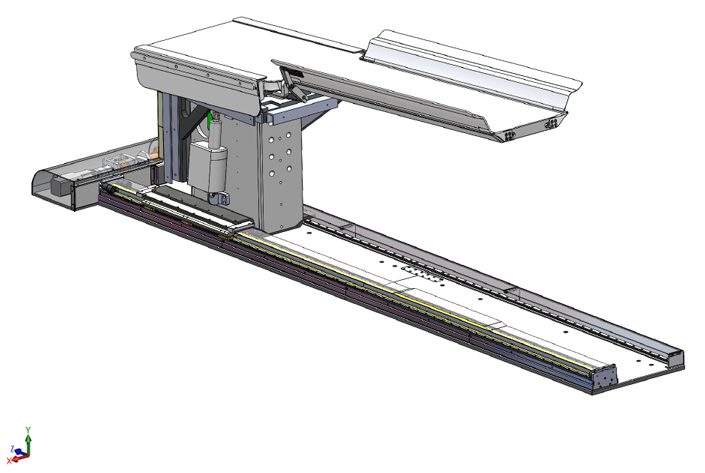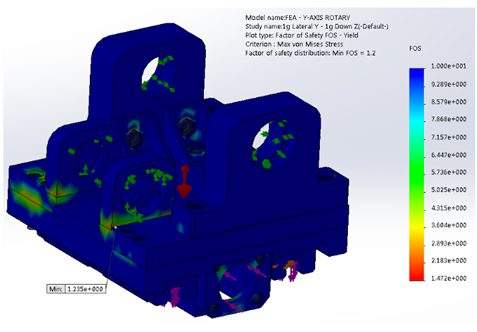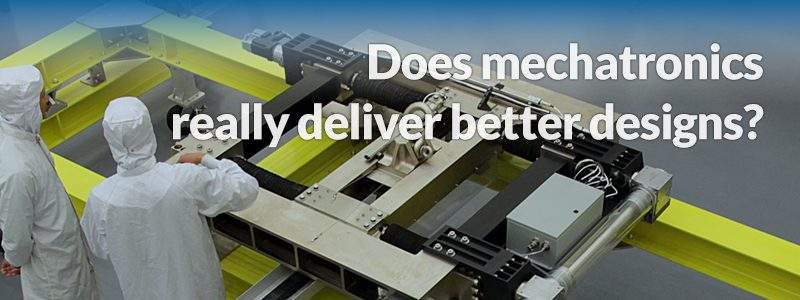Two things are always in short supply during machine development: time and money. Traditionally, design of motion-based machines has been a serial process. The mechanical engineers would design the frame and the motion elements. They would pass the mechanical design along to the electrical engineers, who would specify the motors, drives, controllers, and feedback devices necessary to meet spec. Finally, the system would be handed over to the controls engineers who were responsible for making the finished machine operate to spec. This silo method wasted both time and money. Frequently, prototypes revealed errors that were not caught earlier in the process, leading to expensive reworks and missed deadlines. At Motion Solutions, we think there is a better way: an integrated design approach known as mechatronics.
Mechatronics emphasizes an interdisciplinary approach to machine development. Instead of each engineering group performing their tasks separately, all teams participate from the very beginning. They exchange feedback at every step in the process. This is really the only way to build sophisticated electromechanical systems.
For an example, consider a patient bed in a medical diagnostic system. The unit needed to offer high-speed, precise positioning while being strong enough to hold even very heavy patients without introducing error or increasing settling time. In addition, space constraints required that all electronics be located under the bed.
It is impossible to effectively design this type of system without a multidisciplinary approach. We had to know the size of the motors, the gearboxes, and the other sensors during the mechanical design to ensure that everything would fit and there were no surprises. Because this was a medical device, it had to satisfy redundancy requirements by including dual position sensors. These devices need to be included in the CAD model upfront to guarantee that there was enough space and that the system performed to specifications (see figure 1). If we had not planned ahead for the sensors during mechanical design, there would not have been room.

Detailed modeling that takes into account both mechanical and electrical specifications makes it possible to efficiently design solutions for space-constrained applications like this patient bed for an MRI machine.
The integrated approach also helps with cabling design. It’s easy to focus on the mechanical design and electronics, but cabling design is one of the most tricky aspects of space constrained electromechanical systems. Factors to take into account range from bending radius to cable diameter to threat of crosstalk. As a result, cabling has to be taken into consideration from the very beginning.
A model-based approach
The shift to mechatronic design has been enabled in part by the development of sophisticated software tools. We apply finite element analysis and perform extensive simulations and modeling to understand exactly what the design will look like and how it will perform before we build anything (see figure 2). We also take advantage of sizing software to select the appropriate motors, gearboxes, and drives. We put processes in place that make it easy to reevaluate any time there is a nontrivial change in the design. In the project above, for example, we wound up designing eight models, standardized around two separate approaches.

Using finite element analysis, we generated this rendering showing factor of safety (FOS) – essentially, a measure of a structure’s ability to survive stress during operation – for a complex mechanical system. The simulation enables us to identify regions of high stress that we can work on to improve performance in future designs.
Particularly for complex problems, mechatronics provides a more efficient path to an optimal solution. Over the 60 years that Motion Solutions has been in business, our Engineered Solutions team has developed hundreds of simple XYZ systems. By now, we have solved the various kinds of problems that come up with these sorts of systems, we know where all the “gotchas” are. But when we’re building a very complex system that is completely different than anything we’ve done before, that is when the integrated approach is most important.
Of course, systems have to operate in the real world. We can develop multiple models and run the calculations but when the prototype is built, it may display unexpected results. The more analysis performed upfront, the lower the chance of major design changes. At Motion Solutions, we also have a major advantage – a team of 20 engineers with hundreds of years of aggregate design experience among them.
We apply these skills to help our customers, whether they are commissioning a clean-sheet design or just ordering a part. Sometimes, a customer may come to us saying they have a problem with their ballscrew or motor and asking us to troubleshoot that component. Frequently, though, that component is not the root problem. If we go back to the beginning and get all the details on the system, we find out that it’s not an issue with the motor, it’s not an issue with the ballscrew. Maybe it is the bearing or the mount. You need to have an entire picture of the whole system and understand how it works before you can diagnose the problem.
Our goal at Motion Solutions is to function as an extension of our customers’ engineering teams. When they come to us, they are not just dealing with one engineer, they are getting access to our staff of experts. This is particularly important today, when many organizations have limited engineering resources. In order to replicate what we offer, they might need to add four or five engineers. That’s not always possible. Sometimes, it’s a matter of budgets. Other times, they may only need these capabilities for single project. This is when they come to Motion Solutions for help.
Complex designs require partners that understand mechatronics because that is the most effective route to the best design. At Motion Solutions, our engineers can optimize around all aspects of the problem, whether mechanical or electrical or controls. We bring our complete team together on a project from the very beginning, engineers who understand the entire project. We don’t get involved in serial design. For us, development is always an integrated process.

About the Author
Wally Logan is vice president of engineering at Motion Solutions.




